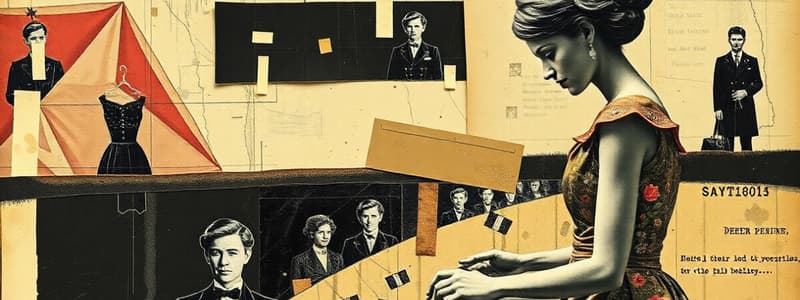Podcast
Questions and Answers
What is the primary role of a Fashion Designer?
What is the primary role of a Fashion Designer?
- Design fashionable clothes (correct)
- Teach sewing techniques
- Manage a dress shop
- Create new textiles and materials
Which embroidery stitch is considered the simplest?
Which embroidery stitch is considered the simplest?
- Running Stitch (correct)
- Cross Stitch
- Back Stitch
- Chain Stitch
What does a Dress Shop Manager primarily ensure?
What does a Dress Shop Manager primarily ensure?
- The quality of clothes and timely delivery (correct)
- The research and analysis of textiles
- The operation of sewing machines
- The creative design of garments
Who is responsible for teaching people how to sew or make dresses?
Who is responsible for teaching people how to sew or make dresses?
What is the function of a Textile Researcher?
What is the function of a Textile Researcher?
Which job role primarily focuses on the preparation of materials for garments?
Which job role primarily focuses on the preparation of materials for garments?
What distinguishes the Back Stitch from other stitches?
What distinguishes the Back Stitch from other stitches?
Which of the following is a common advantage of embroidery as a hobby?
Which of the following is a common advantage of embroidery as a hobby?
Flashcards
Dressmaking
Dressmaking
The craft of sewing clothes and dresses.
Sewing Jobs
Sewing Jobs
Variety of roles in sewing, including sewers, tailors, seamstresses, garment cutters, and more
Garment Cutter
Garment Cutter
Preparing materials for sewing garments.
Running Stitch
Running Stitch
Signup and view all the flashcards
Back Stitch
Back Stitch
Signup and view all the flashcards
Embroidery
Embroidery
Signup and view all the flashcards
Apparel Manufacturers
Apparel Manufacturers
Signup and view all the flashcards
Fashion Designer
Fashion Designer
Signup and view all the flashcards
Study Notes
Dressmaking Overview
- Dressmaking is the craft of sewing clothes and dresses.
- Evidence of dressmaking dates back 6,000 years in Egypt (linen textiles) and 5,000 years in China (silk).
Dressmaking Jobs
- Sewers/Tailors/Seamstresses: Sew, alter clothes, fabrics, and apparel. Can run their own businesses or work in tailoring shops.
- Garment Cutters/Construction Workers/Digital Designers: Prepare materials for sewing garments. Work in various environments, with different materials.
- Apparel Manufacturers: Design and produce clothing items for sale.
- Fashion Designers: Create the specific look of garments; design fashionable clothes.
- Dress Shop Managers: Ensure high quality and timely delivery of clothes to customers.
- Sewing Machine Operators: Operate sewing machines for garment tasks like joining, reinforcing, and decorating.
- Textile Researchers: Study textile designs and materials.
- Dressmaking Teachers: Teach others sewing or dressmaking skills.
Embroidery - Basic Stitches
- Embroidery is an art form that has global appeal, offering creative, emotional, and stress-reducing benefits; it's inexpensive and personal.
- Running Stitch: Simplest stitch; used in hand sewing for seams and gathering fabrics.
- Poke needle down, pull thread down to first stitch.
- Poke needle up, create a space from the previous stitch, then poke down for the second stitch.
- Back Stitch: Stitches backwards from previous stitches.
- Poke needle up, down to create first stitch.
- Poke needle up, create space; poke down to the end of previous stitch.
- Repeat this pattern to complete the stitch.
- Satin Stitch: Series of straight stitches next to each other.
- Bring needle up from the back at the edge of the area to be filled.
- Insert needle down on the opposite side directly across.
- Repeat, coming up on the same side each time.
Studying That Suits You
Use AI to generate personalized quizzes and flashcards to suit your learning preferences.
Description
Explore the fascinating world of dressmaking, a craft with a rich history dating back thousands of years. Discover various careers within the field, from sewers and tailors to fashion designers and garment manufacturers, and learn about their roles in the fashion industry.




